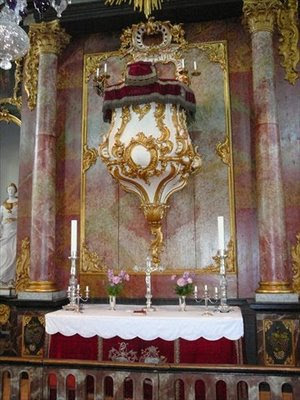
Wednesday July 1 we enjoyed our final breakfast at Per’s, following which Per played some music for us, first on his
Hammond B3, and then on one of his
accordions. He is an excellent musician, and we heard more evidence of this in the car on the way to Kongsberg as he played us a recording from a band he was part of. He also gave us a CD of his most recent recording and we look forward to being able to play it when we get back to Canada.
Per and Truls drove us to Kongsberg (saving us from taking the train, a very generous act on their part). Along the way they showed us various places of interest (and told us that the round straw bales wrapped in white plastic are known in Norway as
tractor eggs). We saw the largest Ski Jump in Norway, and I wondered if that sport would ever grow in Canada. With the Olympic facilities in Calgary I thought that might have happened, but perhaps we are too stuck on hockey (which is not a big sport in Norway unlike its neighbour Sweden). The Ski Jump facility in Oslo could hold crowds of over 50,000 spectators, it is a big deal in Norway.
In
Kongsberg we settled into our Hostel Room - and were pleased to discover that it was a nice facility, but unfortunately it had no air conditioning (and our room faced south, so it got a little warm to say the least). Of all the hostels I have been in I think this may have been the nicest, but then again it was also the most expensive to stay in by far (but cheaper than staying in one of the local hotels which were twice as much money or more!) Speaking of money, Kongsberg was originally a town built around the
silver mines, and silver is the theme of the city. From what I understood the coins for Norwegian currency have been minted in Kongsberg as long as there have been Norwegian coins - we saw the building where the Royal Norwegian Mint is currently housed.
Beth and I wandered around in the afternoon (with the purpose of finding the venues for the evening concerts at the Jazz Festival). The
Tubaloon (a special structure designed for the Jazz Festival as their main stage), was actually quite close to our Hostel - right next to the famous
Kongsberg Church. This structure, partially framework, and partially inflated fabric, is supposed to represent the inner ear in a stylized manner… certainly is interesting to look at.
We didn’t think the Kongsberg Church was much to look at from the outside, but we had some time and so we went in (had to pay admission however). The inside took us completely by surprise - baroque and big (seated 2400). Apparently the church was designed by two architects, the first was a pietist who didn’t have much use for excessive adornment, he was responsible for the exterior of the building. After he died another architect took over, and he was a flamboyant man - which accounted for the drastically different approach to the interior. Some interesting features of this church:
- the pulpit was built into the altar piece (right above the altar and below the pipe organ - see the picture, that‘s the pulpit and altar - note the large silver candlestick holders).
- there was a box for royalty (just like a theatre box) still used today only for royal visits.
- the main chandeliers were made with multi-coloured glass (very unique and very expensive).
- the altar faces west (rather than east) because this was the direction of the mountain with the silver in it, something the Kongsberg folks felt was a blessing from God (though to me it almost seemed like it was a subtle statement about the worship of money rather than God).
During our time looking about the church we heard the Danish Big Band warming up outside, this whet my appetite for the first concert of the evening (especially this nice synth keyboard playing… which I later found out was something else). Following our time in the church we walked into the city centre, where many booths were set up selling a variety of goods: hand crafted jewellery, clothes, art items, and so forth. We found the Kino (or Cinema) where the Tord Gustavsen concert would be later in the evening and then we headed back to our room where we rested and did a little internet work (the hostel had free internet!)
 One of the sites we looked at in the Kolbu area On July 3rd was the local church. When we were walking into the church yard I noticed a familiar looking sign post - it was a pilgrimage marker, just like the one we saw at the Bønsnes Kirke in Hole! A quick look at a descriptive sign confirmed that this church was another stop on the Ancient Pilgrimage Route to Trondheim. This was another of those amazing coincidence moments from our trip - to discover that both our families were connected by this ancient pilgrimage route.
One of the sites we looked at in the Kolbu area On July 3rd was the local church. When we were walking into the church yard I noticed a familiar looking sign post - it was a pilgrimage marker, just like the one we saw at the Bønsnes Kirke in Hole! A quick look at a descriptive sign confirmed that this church was another stop on the Ancient Pilgrimage Route to Trondheim. This was another of those amazing coincidence moments from our trip - to discover that both our families were connected by this ancient pilgrimage route.
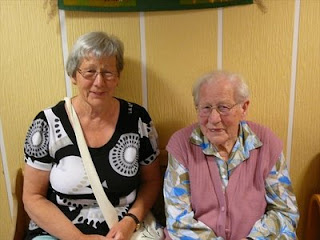 We must have been tired because once again we slept in (seems to be a recurring theme, time to think of going home). When we got up we had a nice breakfast with Kari, Magne and Roar; then it was time for Roar to leave - he was committed to providing some musical entertainment at the Senior’s Home where his mother now lives.
We must have been tired because once again we slept in (seems to be a recurring theme, time to think of going home). When we got up we had a nice breakfast with Kari, Magne and Roar; then it was time for Roar to leave - he was committed to providing some musical entertainment at the Senior’s Home where his mother now lives.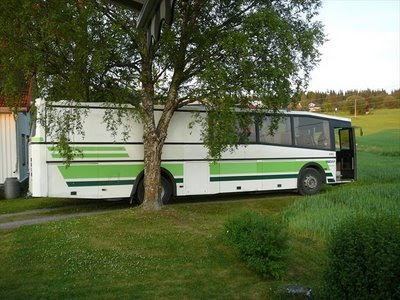 Now it was time for us to reconnect with my side of the family. I had made arrangements with a relative (also named Kari and married to a man named Magne, how confusing is that!) that we should spend some time with her at their farm near Kolbu, north of Oslo. Kari’s grandmother is a cousin of my grandfather (her mother is a first cousin of my mother, I’m not sure what that makes us.) We had met her when she was in Canada a few years ago and she had come to our house with my parents.
Now it was time for us to reconnect with my side of the family. I had made arrangements with a relative (also named Kari and married to a man named Magne, how confusing is that!) that we should spend some time with her at their farm near Kolbu, north of Oslo. Kari’s grandmother is a cousin of my grandfather (her mother is a first cousin of my mother, I’m not sure what that makes us.) We had met her when she was in Canada a few years ago and she had come to our house with my parents.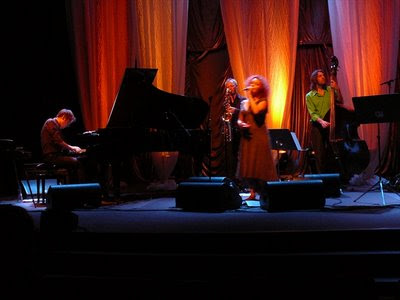
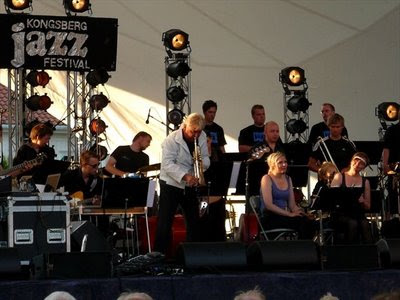
 Wednesday July 1 we enjoyed our final breakfast at Per’s, following which Per played some music for us, first on his Hammond B3, and then on one of his accordions. He is an excellent musician, and we heard more evidence of this in the car on the way to Kongsberg as he played us a recording from a band he was part of. He also gave us a CD of his most recent recording and we look forward to being able to play it when we get back to Canada.
Wednesday July 1 we enjoyed our final breakfast at Per’s, following which Per played some music for us, first on his Hammond B3, and then on one of his accordions. He is an excellent musician, and we heard more evidence of this in the car on the way to Kongsberg as he played us a recording from a band he was part of. He also gave us a CD of his most recent recording and we look forward to being able to play it when we get back to Canada. Our tour around the Royse area (where the Nosterud farm is situated) continued with a trip to the Hole Church (not 'hole' as in a empty space, but a Norwegian named pronounced something like hol-la), which was rebuilt after a fire in the 40s. I think that this was the church my grandparents were married in (though none of the cousins could answer that for sure). The rebuilt church has a very modern design painted on the ceiling, certainly not what we expected when we first walked in. The over all look of the sanctuary was simple and uncluttered (very different from all the other churches we have visited in Europe), only some decorative items from the original church building that were rescued from fire (the altar piece for example) were more fancy in appearance.
Our tour around the Royse area (where the Nosterud farm is situated) continued with a trip to the Hole Church (not 'hole' as in a empty space, but a Norwegian named pronounced something like hol-la), which was rebuilt after a fire in the 40s. I think that this was the church my grandparents were married in (though none of the cousins could answer that for sure). The rebuilt church has a very modern design painted on the ceiling, certainly not what we expected when we first walked in. The over all look of the sanctuary was simple and uncluttered (very different from all the other churches we have visited in Europe), only some decorative items from the original church building that were rescued from fire (the altar piece for example) were more fancy in appearance.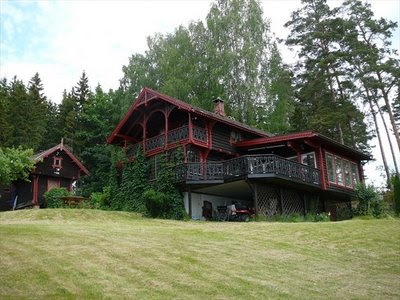
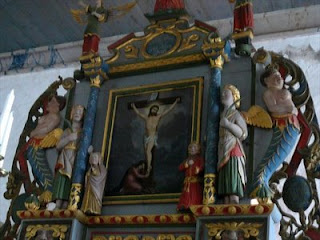 Tuesday morning, June 30th, we awoke to another beautiful day in Norway. After a nice breakfast at Per‘s we loaded into cars and went on a tour of the area. The first stop was the Bønsnes Kirke (Church). King Olav the Saint (995 to 1030 AD) was born near the site of the church and there is a tale that says it was built by the King himself (the tale says during a voyage on the Tyrifjord Lake he found his life in danger and he promised to build a church if he and his men would reach the shore alive). Olav is important in Norwegian history because he is the first King to establish what would become the modern borders of Norway, unifying the people (at least briefly) of the whole land. He is considered a saint because he brought Christianity to the interior and north of Norway, and after he died people claimed to be healed by his relics - thus began a long tradition of pilgrimages to Trondheim where Olav was buried. This Bønsnes Kirke was one of the stops on the pilgrimage journey.
Tuesday morning, June 30th, we awoke to another beautiful day in Norway. After a nice breakfast at Per‘s we loaded into cars and went on a tour of the area. The first stop was the Bønsnes Kirke (Church). King Olav the Saint (995 to 1030 AD) was born near the site of the church and there is a tale that says it was built by the King himself (the tale says during a voyage on the Tyrifjord Lake he found his life in danger and he promised to build a church if he and his men would reach the shore alive). Olav is important in Norwegian history because he is the first King to establish what would become the modern borders of Norway, unifying the people (at least briefly) of the whole land. He is considered a saint because he brought Christianity to the interior and north of Norway, and after he died people claimed to be healed by his relics - thus began a long tradition of pilgrimages to Trondheim where Olav was buried. This Bønsnes Kirke was one of the stops on the pilgrimage journey.

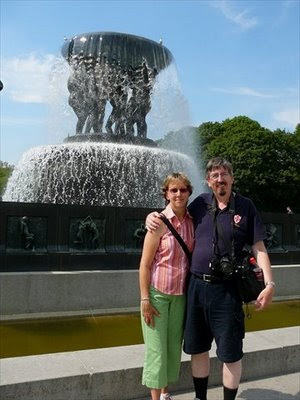 After the visit to Rainbow Studio we began a walking tour of Oslo with Kari Grande. We walked down the path by the river, going through the old textile mill area. The river was lovely, and the coolness that we felt walking beside the water and in the shade of the trees was welcome on a very hot day. There were some nice waterfalls and interesting buildings. Along the way Kari would give us bits of history, pointing out various monuments, buildings and sites.
After the visit to Rainbow Studio we began a walking tour of Oslo with Kari Grande. We walked down the path by the river, going through the old textile mill area. The river was lovely, and the coolness that we felt walking beside the water and in the shade of the trees was welcome on a very hot day. There were some nice waterfalls and interesting buildings. Along the way Kari would give us bits of history, pointing out various monuments, buildings and sites.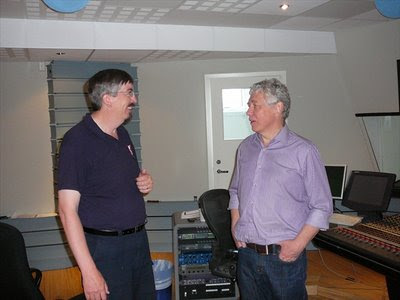
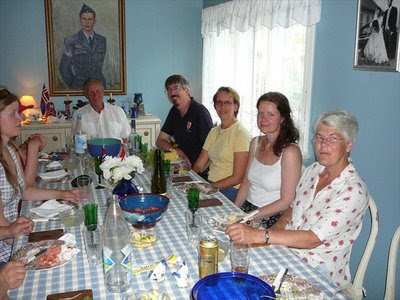

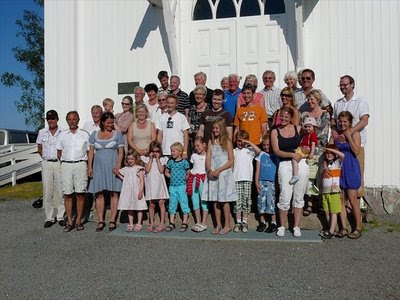
 Saturday June 27th started with a lovely breakfast, at which both of Sissel and Terje’s boys showed up. When I visited back in 1980 they were just boys with whom I enjoyed playing (being nothing more than a big boy at that stage anyways). Now they are grown men with families of their own. Leif is a dentist (with a practice in Oslo) who lives on the farm in the house I talked about in the previous post - he and his wife Tone have three children. Tryggve is a teacher and lives with his wife Kjersti and two children in Fetsund, about a 20 minute drive from the farm. Tryggve pulled into the yard in his sports car, and I found out that up until a couple of years ago he raced motorcycles (much to the concern of his mother).
Saturday June 27th started with a lovely breakfast, at which both of Sissel and Terje’s boys showed up. When I visited back in 1980 they were just boys with whom I enjoyed playing (being nothing more than a big boy at that stage anyways). Now they are grown men with families of their own. Leif is a dentist (with a practice in Oslo) who lives on the farm in the house I talked about in the previous post - he and his wife Tone have three children. Tryggve is a teacher and lives with his wife Kjersti and two children in Fetsund, about a 20 minute drive from the farm. Tryggve pulled into the yard in his sports car, and I found out that up until a couple of years ago he raced motorcycles (much to the concern of his mother).
